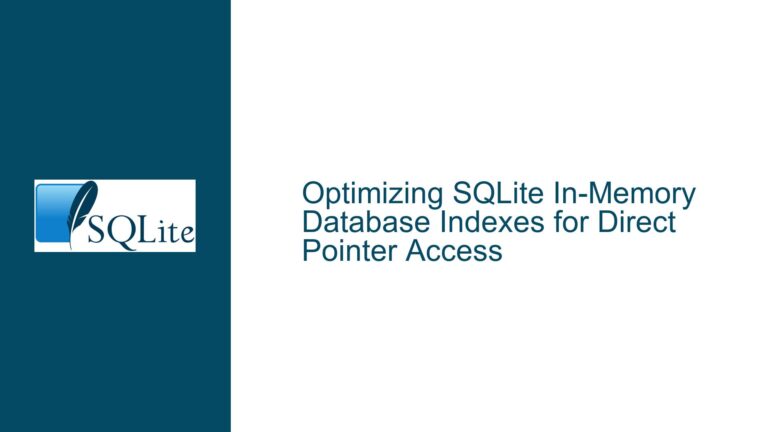Transaction Upgrades in SQLite During INSERT INTO SELECT Operations
Transaction Behavior During INSERT INTO SELECT Operations
When working with SQLite, understanding the nuances of transaction behavior is crucial, especially when dealing with operations that involve both reading and writing data, such as INSERT INTO SELECT. This operation combines an insertion of data into a table with a selection of data from another table or the same table. The core issue revolves around when and how the transaction is upgraded to IMMEDIATE or EXCLUSIVE mode during the execution of such a statement. This upgrade is significant because it determines the level of isolation and consistency guarantees provided by the database during the operation.
In SQLite, transactions can be in one of three states: DEFERRED, IMMEDIATE, or EXCLUSIVE. A DEFERRED transaction does not acquire any locks until it is necessary, allowing other transactions to read or write to the database until the deferred transaction itself attempts to write. An IMMEDIATE transaction attempts to acquire a reserved lock immediately, preventing other transactions from writing to the database but allowing reads. An EXCLUSIVE transaction acquires a write lock, preventing other transactions from both reading and writing.
The INSERT INTO SELECT statement is particularly interesting because it involves both reading (the SELECT part) and writing (the INSERT part). The question arises: at what point does the transaction upgrade from DEFERRED to IMMEDIATE or EXCLUSIVE? Does the upgrade occur before the SELECT part is executed, ensuring a consistent read, or after, potentially allowing other transactions to modify the data being read?
Possible Causes of Transaction Upgrade Timing Issues
The timing of the transaction upgrade in SQLite during an INSERT INTO SELECT operation can be influenced by several factors. One of the primary considerations is whether the operation is executed within an explicit transaction or as a standalone statement. When executed outside an explicit transaction, SQLite automatically starts a transaction appropriate to the operation being performed. For INSERT INTO SELECT, this would typically be an IMMEDIATE transaction since the operation involves writing to the database.
However, when the operation is executed within an explicit DEFERRED transaction, the behavior becomes more nuanced. The transaction starts in DEFERRED mode, meaning it does not acquire any locks initially. The upgrade to IMMEDIATE or EXCLUSIVE mode occurs when the transaction attempts to write to the database. In the case of INSERT INTO SELECT, this would be when the INSERT part of the statement is executed. But the critical question is whether the SELECT part of the statement is executed before or after the upgrade.
Another factor to consider is the isolation level provided by SQLite. SQLite uses a lock-based concurrency control mechanism, and the isolation level is determined by the type of locks acquired during the transaction. If the SELECT part of the statement is executed before the upgrade to IMMEDIATE or EXCLUSIVE, it is possible for other transactions to modify the data being read, leading to potential inconsistencies. On the other hand, if the upgrade occurs before the SELECT, the transaction would have a consistent view of the data, preventing other transactions from modifying it until the current transaction is complete.
The behavior of SQLite in this regard is also influenced by the version of SQLite being used. In SQLite 3.24 and later, there is a TRANSACTION opcode in the prolog of the generated SQLite bytecode. Executing this opcode results in a write transaction being started or upgraded, or the statement failing if it is not possible to do so. This means that in newer versions of SQLite, the upgrade to IMMEDIATE or EXCLUSIVE mode is more predictable and occurs before the SELECT part of the statement is executed.
Troubleshooting Steps, Solutions & Fixes for Ensuring Consistent Reads
To ensure consistent reads during INSERT INTO SELECT operations in SQLite, it is essential to understand and control the transaction behavior. Here are some steps and solutions to address the potential issues:
Explicit Transaction Control: Always use explicit transactions when performing
INSERT INTO SELECToperations. This allows you to control the transaction mode and ensure that the upgrade toIMMEDIATEorEXCLUSIVEoccurs at the desired point. For example, you can start the transaction inIMMEDIATEmode explicitly:BEGIN IMMEDIATE; INSERT INTO blah SELECT COALESCE(MAX(a), 0) + 1 FROM blah; COMMIT;This ensures that the transaction is in
IMMEDIATEmode before theSELECTpart of the statement is executed, providing a consistent read.Testing with Concurrent Transactions: To verify the behavior of your
INSERT INTO SELECToperations, you can test them with concurrent transactions. Use two instances of the SQLite CLI to simulate concurrent access. In one instance, start a long-running transaction that performs aSELECTwith a delay (e.g., using theedit()function in the CLI). In the other instance, attempt to perform anINSERToperation. This will help you observe whether theSELECTpart of the statement is executed before or after the transaction upgrade.Understanding SQLite Version Differences: Be aware of the differences in transaction behavior between different versions of SQLite. If you are using SQLite 3.24 or later, the
TRANSACTIONopcode in the bytecode ensures that the upgrade toIMMEDIATEorEXCLUSIVEmode occurs before theSELECTpart of the statement is executed. If you are using an older version, you may need to take additional steps to ensure consistent reads.Handling Lock Contention: In scenarios where multiple transactions are contending for locks, it is essential to handle potential lock contention gracefully. Use appropriate timeout settings and retry logic to handle cases where the transaction upgrade fails due to lock contention. For example, you can use the
BEGIN IMMEDIATEstatement with a timeout:BEGIN IMMEDIATE; INSERT INTO blah SELECT COALESCE(MAX(a), 0) + 1 FROM blah; COMMIT;If the transaction cannot acquire the necessary locks within the timeout period, it will fail, and you can retry the operation.
Avoiding Primary Key Violations: To ensure that your
INSERT INTO SELECToperations do not result in primary key violations, you can use techniques such asCOALESCE(MAX(a), 0) + 1to generate unique primary key values. However, this approach relies on the assumption that no other transaction will insert a row with the same primary key value before the current transaction completes. By ensuring that the transaction is inIMMEDIATEorEXCLUSIVEmode before theSELECTpart of the statement is executed, you can prevent other transactions from modifying the data and avoid primary key violations.Using SQLite’s Locking Mechanism: SQLite’s locking mechanism provides different levels of isolation and consistency guarantees. By understanding how locks are acquired and released during transactions, you can design your
INSERT INTO SELECToperations to ensure consistent reads. For example, you can use theEXCLUSIVEtransaction mode to prevent other transactions from reading or writing to the database until the current transaction is complete:BEGIN EXCLUSIVE; INSERT INTO blah SELECT COALESCE(MAX(a), 0) + 1 FROM blah; COMMIT;This ensures that no other transactions can modify the data being read by the
SELECTpart of the statement.Monitoring and Logging: Implement monitoring and logging to track the behavior of your
INSERT INTO SELECToperations. Use SQLite’s built-in logging capabilities or external tools to monitor transaction states, lock acquisition, and potential contention issues. This will help you identify and troubleshoot any issues related to transaction upgrades and ensure consistent reads.
By following these steps and solutions, you can ensure that your INSERT INTO SELECT operations in SQLite provide consistent reads and avoid potential issues related to transaction upgrades. Understanding the behavior of SQLite’s transaction mechanism and controlling it explicitly will help you design robust and reliable database operations.






